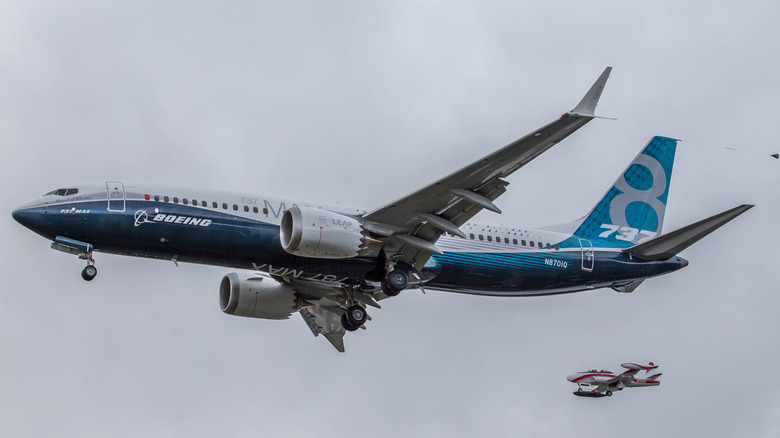The Weird Boeing 737 Quirk That Allows It To Carry More Passengers
The Boeing 737 family is a collection of aircraft known for reliability, fuel efficiency, and versatility, making it one of the most popular and successful commercial aircraft in history. The 737's different variants allow it to serve a wide range of markets and needs, from shorter domestic routes to longer international flights. Its strategic versatility is great for business since increased seating capacity equals higher revenue for any particular airline; for passengers, fewer seats in the standard configuration would generally mean more room in the cabin, which demonstrates exactly how small design changes can make a huge difference in the airline industry. Boeing's 737 MAX 8‑200 variant, often called the MAX 200, has a quirk that allows it to carry more passengers and earn even more profit.
A two-class MAX 8 standard layout seats between 162-178 passengers, while its MAX 8‑200 (high-density version) has a maximum certified capacity is 210 passengers, but operators like Ryanair have configured it with fewer, such as 197 seats. Boeing's MAX 8‑200 uses the same base airframe as its MAX 8, yet made some tweaks, which include extra emergency exits and a high‑density cabin layout. Boeing's MAX 10 standard configuration typically seats around 188–200 and can be configured for up to 230 in a single-class high-density layout.
How and why Boeing fit more passengers into the same-sized 737
Boeing's purpose for redesigning the 737 MAX 8 to the MAX 200 variant was to serve low-cost carriers and short-haul markets that needed more seats per flight, increasing overall profits. To achieve this, small technical adjustments to the cabin were required, beginning with a seat pitch reduction. Seat pitch is the distance from a given point on one seat to the same point on the seat in front of it, indicating how much legroom each passenger has. Reducing seat pitch means an airline carrier can move seats closer together to make room for more rows in the cabin. Next, the rows had to be adjusted to ensure all were added and fitted equally according to the new specifications. These simple adjustments are the "high-density" hack, making it possible to carry more passengers without drastically changing the plane's size, sacrificing a little leg room for more people.
Two more emergency exits were added midplane for certification reasons to stay within safety regulations, increasing the number from eight to ten. Another reason to redesign the MAX 8 was to compete with the Airbus A320neo. This led to other core changes to modernize the existing 737 platform, including upgrading its engines to the larger, more advanced LEAP-1B Engines, enhancing performance, utilizing split scimitar winglets to improve aerodynamics, and varying the fuselage lengths across the MAX family variants, consisting of the MAX 7, 8, 9, and 10. Due to the A320neo's strong efficiency gains and seating flexibility, the manufacturer had to answer with its MAX lineup to protect its market dominance. The MAX 8-200 gives Boeing a chance to remain competitive and shows how incremental innovation is sometimes better than radical redesign.

